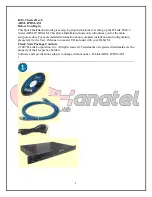
6
Specifications
Card Address:
Determined by software and DIP switch configuration
Watchdog Timers:
Fixed:
1.5 s maximum
Windowed:
3 ms minimum, 80 ms maximum
Host Network Compatibility:
1000/100/10 MB TX full-duplex with auto-negotiation
I/O Network Compatibility:
1 GB TX full-duplex with auto-negotiation
Ethernet Cable Length:
328 feet (100 meters) maximum, card to switch or card to card
Ethernet Cable Type:
STP Category 5 (EIA 568B, Cat 5) shielded Ethernet cables with 4 twisted-
pair wires and RJ-45 tips
Program Memory:
Up to 8,192,000 bytes for PGM files
Up to 2,048,000 bytes for UDL files
Data Memory Type:
512 Mbytes SDRAM
Program Memory Type:
32 Mbytes program flash
Power Requirements:
+5 VDC @ 1.75 Amps
Battery:
Processor contains a lithium battery (see Figure 2) that powers the time-of-
day clock whenever power to chassis is turned off. The expected life span
of this battery is five (5) years. Replace this battery only with an agency-
approved battery of the same voltage and capacity (3V, 180 mAh). Two
recommended replacements are:
Panasonic part number BR 2032
Varta part number CR 2032
WARNING!
If you replace the battery with an incorrect type, it may
explode.
Do not
dispose of batteries in the trash. Dispose of batteries according to
local regulations.
Please recycle according to local regulations.
Programming Tools:
NetArrays Developer Studio
Programming Languages:
Flow Charts, Objects, Structured Text, C/C++, Fuzzy Logic, Ladder Logic
Processor Utilization:
Processor can be configured for cyclic execution from 1ms to 25ms.
Processor utilization is measured via Node Info Object, which reports the
reserve time in each execution cycle.
Processing of I/O:
The 3200T/3201 Processor communicates each scan cycle with the
Chassis I/O. Inputs from the modules are processed in the user
application program after two scan cycles. Computational results of the
user application program are sent back to the modules to activate the
outputs.
Self-Tests and Diagnostics:
Processor performs a Power-On-Self-Test (POST) upon cold startup or if
instructed by the Node Shutdown object. POST includes comprehensive
memory tests and verification of the onboard peripherals. Runtime
diagnostics tests CPU, registers and allocated memory.







































